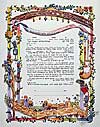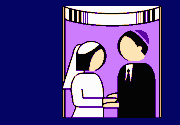Jewish Wedding Customs
We hope that this explanation of traditional Jewish wedding rituals and customs will further enhance your enjoyment of this special occasion, and make this day more meaningful for all of us.
Kabbalat Panim (Greeting of the Bride and Groom)
Prior to the ceremony the bride (called the Kallah) and the groom (called the Chattan) are in separate areas greeting the guests. Separate receptions are held for the bride and the groom because they are not supposed to see each other until the ceremonial veiling of the bride. On the wedding day the bride and groom are likened to a king and queen. The bride is seated on a bridal throne and is greeted by guests. The groom is seated at the Groom’s Reception (called the Chattan’s Tish), where the legal components of the marriage are finalized. First is the signing of the Tenaim, which signifies that both families agree to bring their children together for marriage. After the Tenaim are read and signed there is a tradition that the two mothers break a plate together, for even in the midst of joy we must remember the destruction of the Holy Temple.  The groom then reads over the Ketubah (marriage contract), a document written in Aramaic and dating back to at least the second century BCE, which details the obligations of the husband to the wife. Next the Ketubah is signed by two witnesses.
The groom then reads over the Ketubah (marriage contract), a document written in Aramaic and dating back to at least the second century BCE, which details the obligations of the husband to the wife. Next the Ketubah is signed by two witnesses.
After the signing of the Ketubah, friends and family escort Craig with song and dance to Gail. He places the veil over her face. This touching custom is called the Bedeken, and it has its origins in the Book of Genesis. Abraham sent his servant Eliezer to find a bride for his son, Isaac, and Eliezer chose Rebecca. As they journeyed home, Rebecca covered her face in modesty upon seeing her groom Isaac approach them. The groom does the veiling himself to prevent deceit which was practiced on Jacob by Lavan. Thus the custom arose for the groom to look at the bride’s face before the ceremony. After Gail is veiled, she receives traditional blessings from her father.
Craig is then danced away from Gail, and the guests are seated for the ceremony.
The Ceremony
The ceremony takes place under the Chuppah, a canopy, which is open on all four sides. This chuppah is made from the Tallit (prayer shawl) of Gail’s grandfather of blessed memory.  The chuppah symbolizes the home that Gail and Craig will build together. Like Abraham’s tent it is open on all sides, so that visitors know they are welcome. It further symbolizes that although Craig and Gail will have their own home, they must not forget to go out to the community as well. Once all members of the wedding party reach the chuppah, Gail circles Craig seven times. Seven symbolizes the seven days of creation. Through marriage Gail and Craig are, in some sense, building their own world. Seven also stands for the seven references to marriage found in the Torah. Finally, seven is based on the fact that the tefillin straps are wrapped around a man’s arm seven times, and just as a man binds himself to G-d, so too are the bride and groom bound to each other.
The chuppah symbolizes the home that Gail and Craig will build together. Like Abraham’s tent it is open on all sides, so that visitors know they are welcome. It further symbolizes that although Craig and Gail will have their own home, they must not forget to go out to the community as well. Once all members of the wedding party reach the chuppah, Gail circles Craig seven times. Seven symbolizes the seven days of creation. Through marriage Gail and Craig are, in some sense, building their own world. Seven also stands for the seven references to marriage found in the Torah. Finally, seven is based on the fact that the tefillin straps are wrapped around a man’s arm seven times, and just as a man binds himself to G-d, so too are the bride and groom bound to each other.
The ceremony itself consists of two parts: Kiddushin (the Betrothal) and Nisuin (the Nuptial).
Kiddushin:
The M’Sader Kiddushin, officiant, recites two blessings. The first blessing is said over a cup of wine; a symbol of joy and abundance, and the second blessing thanks G-d for the sanctity of marriage. Gail and Craig then sip from the wine over which the blessings were recited. Two witnesses, Eidei Kiddushin, are then called up to affirm that the ring that Craig will give to Gail is indeed of value.  Once they do, Craig then places the ring on Gail’s right forefinger, so that it may be seen by the two witnesses. Craig recites in Hebrew the traditional words of betrothal, “Behold you are consecrated unto me with this ring according to the laws of Moses and Israel.” The ring, being circular and without end, symbolizes the eternity and the permanence of the marriage. By extending her finger to accept the ring, Gail signifies her active agreement to the Kiddushin. The Ketubah is then read in its original Aramaic and given to the bride. The reading of the Ketubah serves as a separation between Kiddushin and Nisuin.
Once they do, Craig then places the ring on Gail’s right forefinger, so that it may be seen by the two witnesses. Craig recites in Hebrew the traditional words of betrothal, “Behold you are consecrated unto me with this ring according to the laws of Moses and Israel.” The ring, being circular and without end, symbolizes the eternity and the permanence of the marriage. By extending her finger to accept the ring, Gail signifies her active agreement to the Kiddushin. The Ketubah is then read in its original Aramaic and given to the bride. The reading of the Ketubah serves as a separation between Kiddushin and Nisuin.
Nisuin:
The Nisuin celebrates the joining of Gail and Craig to create a new family and thus finalizes the new couple’s receipt of their marriage rights and assumption of their marriage obligations. The Sheva Brachot, Seven Blessings, which initiate and celebrate the Nisuin process are recited by close relatives and honored guests. The first blessing again is sanctification over wine. The next two blessings acknowledge G-d as creator of the universe and of humankind.  The fourth recognizes the equality of all people created in the divine image. The fifth blessing refers to the hope for the unification of the Jewish people in Israel. The sixth asks G-d to bless the couple, and the final blessing asks G-d to bestow happiness on Israel and the entire world. Following the blessings Gail and Craig drink some of the wine.
The fourth recognizes the equality of all people created in the divine image. The fifth blessing refers to the hope for the unification of the Jewish people in Israel. The sixth asks G-d to bless the couple, and the final blessing asks G-d to bestow happiness on Israel and the entire world. Following the blessings Gail and Craig drink some of the wine.
Breaking The Glass:
At the end of the ceremony Psalm 137:5 is sung,  “If I forget thee, O Jerusalem, let my right hand forget its skill,” and Craig breaks a glass. This custom dates back to the time of the writing of the Talmud, when Mar bar Rabina, at the marriage feast of his son, broke an expensive goblet saying, “Where there is rejoicing there should be trembling.” Since the 14th century, the breaking of the glass has served as a commemoration of the destruction of Jerusalem and the Beit Hamikdash, Holy Temple. The Jewish community remembers that even in this height of joy, no happiness can be complete until the rebuilding of the Temple.
“If I forget thee, O Jerusalem, let my right hand forget its skill,” and Craig breaks a glass. This custom dates back to the time of the writing of the Talmud, when Mar bar Rabina, at the marriage feast of his son, broke an expensive goblet saying, “Where there is rejoicing there should be trembling.” Since the 14th century, the breaking of the glass has served as a commemoration of the destruction of Jerusalem and the Beit Hamikdash, Holy Temple. The Jewish community remembers that even in this height of joy, no happiness can be complete until the rebuilding of the Temple.
Finally with much singing and dancing, the new couple is whisked away by friends to a private room, where they are to share their first moments of married life alone.
Yichud (Union)
After the ceremony, Gail and Craig have a period of privacy which is the culmination of the wedding ceremony. Two witnesses, Eidei Yichud, guard the door to the room to prevent anyone from entering. The seclusion of the bride and groom functions as the symbolic consummation of the marriage.
Seudat Mitzvah (The Festive Meal)
This special meal of heightened joy is called a seudat mitzvah. When Gail and Craig first enter the hall they are greeted with joyous dancing and celebrations. The meal begins with traditional hand washing, after which a public blessing will be made over the bread (HaMotzee). The meal itself is festive and the dancing is very spirited and unrestrained. When the band plays traditional Jewish music, men dance around the groom and women dance around the bride. Often the bride and groom are placed in the center of the circles and entertained with special dances and antics. The reception concludes with the Grace After Meals (Birkat Ha-mazon) and a repetition of the Sheva Brachot .

